
Grappling is a full-contact combat sport based on throws, trips, sweeps, clinch fighting, ground fighting and submission holds.
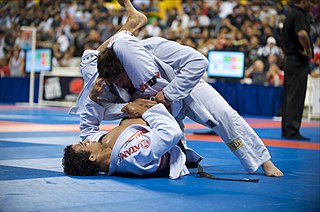
Brazilian jiu-jitsu is a self-defence martial art and combat sport based on grappling, ground fighting, and submission holds. BJJ approaches self-defense by emphasizing taking an opponent to the ground, gaining a dominant position, and using a number of techniques to force them into submission via joint locks or chokeholds.
Professional wrestling holds include a number of set moves and pins used by performers to immobilize their opponents or lead to a submission. This article covers the various pins, stretches and transition holds used in the ring. Some wrestlers use these holds as their finishing maneuvers, often nicknaming them to reflect their character or persona. Moves are listed under general categories whenever possible.
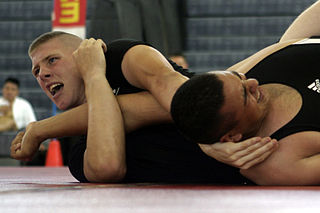
Submission wrestling, also known as Submission grappling or Submission fighting, is a combat sport that focus on clinch and ground fighting with the aim of obtaining a submission through the use of submission holds. The term usually refers to a form of competition and training that does not use the Gi, the "combat kimono" worn in traditional martial arts. No-Gi Brazilian jiu-jitsu (BJJ) is the most well known subset of submission wrestling, with the ADCC Submission Fighting World Championship considered its most prestigious tournament.
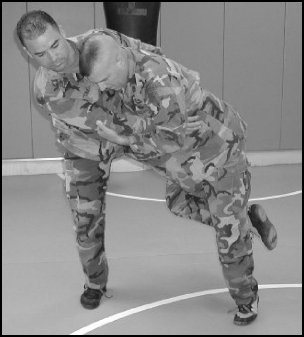
In martial arts and combat sports, a takedown is a technique that involves off-balancing an opponent and bringing them to the ground with the attacker landing on top. The process of quickly advancing on an opponent and attempting a takedown is known as shooting for a takedown, or simply shooting. Takedowns are usually distinguished from throws by amplitude and impact, where the purpose of a throw is to outright eliminate the opponent while purpose of a takedown is to bring the opponent down on the ground, assume a dominant position and then proceed to finish them with jointlocks, chokeholds or ground and pound. In rulesets of many sports such as Judo and Sambo, a well executed throw will end the match while the match will continue on the ground if a takedown is used instead. Takedowns are featured in all forms of wrestling and Judo.
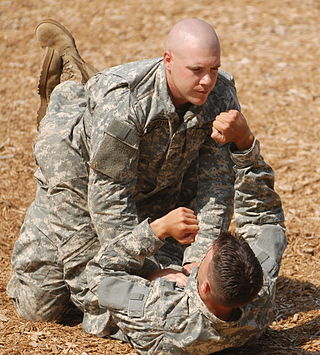
The guard is a ground grappling position in which one combatant has their back to the ground while attempting to control the other combatant using their legs. In pure grappling combat sports, the guard is considered an advantageous position, because the bottom combatant can attack with various joint locks and chokeholds, while the top combatant's priority is the transition into a more dominant position, a process known as passing the guard. In the sport of mixed martial arts, as well as hand-to-hand combat in general, it is possible to effectively strike from the top in the guard, even though the bottom combatant exerts some control. There are various types of guard, with their own advantages and disadvantages.

The Boston crab is a professional wrestling hold that typically starts with one wrestler lying in a supine position on the mat, with the other wrestler standing and facing them. It is a type of spinal lock where the wrestler hooks each of the opponent’s legs in one of their arms and then turns the opponent face-down, stepping over them in the process. The final position has the wrestler in a semi-sitting position and facing away from the opponent, with the opponent’s back and legs bent back toward their head. The original name for the maneuver was the Backbreaker, before that term became known for its current usage. In modern wrestling, the Boston crab is not treated as a lethal submission maneuver, even though it was considered a match-ending hold in the past.

A chokehold, choke, stranglehold or, in Judo, shime-waza is a general term for a grappling hold that critically reduces or prevents either air (choking) or blood (strangling) from passing through the neck of an opponent. The restriction may be of one or both and depends on the hold used and the reaction of the victim. While the time it takes for the choke to render an opponent unconscious varies depending on the type of choke, the average across all has been recorded as 9 seconds.

The rear naked choke (RNC) is a chokehold in martial arts applied from an opponent's back. The word "naked" in this context suggests that, unlike other strangulation techniques found in jujutsu/judo, this hold does not require the use of a keikogi ("gi") or training uniform.
A triangle choke, or sankaku-jime (三角絞) in judo, is a type of figure-four chokehold that encircles the opponent's neck and one arm with the legs in a configuration similar to the shape of a triangle. Applying pressure using both legs and the opponent's own shoulder, the technique is a type of lateral vascular restraint that constricts the blood flow from the carotid arteries to the brain, potentially resulting in loss of consciousness in seconds when applied correctly. Recent studies have shown that the triangle choke takes an average of 9.5 seconds to render an opponent unconscious from the moment it is properly applied.
An armlock in grappling is a single or double joint lock that hyperextends, hyperflexes or hyperrotates the elbow joint or shoulder joint. An armlock that hyper-extends the arm is known as an armbar, and it includes the traditional armbar, pressing their elbow into your thigh, and the triangle armbar, like a triangle choke, but you press their elbow into your thigh. An armlock that hyper-rotates the arm is known as an armcoil, and includes the americana, kimura, and omaplata. Depending on the joint flexibility of a person, armcoils can either hyper-rotate only the shoulder joint, only the elbow joint, or both the elbow joint and shoulder joint. Generally, armcoils hurt more than armbars, as they attack several joints at the bone and muscle.
A leglock is a joint lock that is directed at joints of the leg such as the ankle, knee or hip joint. A leglock which is directed at joints in the foot, is sometimes referred to as a foot lock and a lock at the hip as a hip lock. Leglocks are featured, with various levels of restrictions, in combat sports and martial arts such as Sambo, Brazilian Jiu-Jitsu, catch wrestling, mixed martial arts, Shootwrestling and submission wrestling, but are banned in some sports featuring joint locks such as judo. The technique has been seen across a wide range of different combat sports and is reportedly over 2,500 years old, having been seen in the lost art of Pankration in the original Olympic Games.

Catch wrestling is a classical hybrid grappling style and combat sport. It was developed by J. G. Chambers in Britain c. 1878. It was popularised by wrestlers of travelling funfairs who developed their own submission holds, or "hooks", into their wrestling to increase their effectiveness against their opponents. Catch wrestling derives from various different international styles of wrestling: several English styles. The training of some modern submission wrestlers, professional wrestlers and mixed martial artists is founded in catch wrestling.

Clinch fighting is the part of stand-up fighting where the combatants are grappling in a clinch, typically using clinch holds. Clinching the opponent can be used to eliminate the opponent's effective usage of some kicks, punches, and melee weapons. The clinch can also be used as a medium to switch from stand-up fighting to ground fighting by using takedowns, throws or sweeps.

A nelson hold is a grappling hold which is executed by one person from behind the opponent, generally when both are on the mat face down with the opponent under the aggressor. One or both arms are used to encircle the opponent's arm under the armpit, and secured at the opponent's neck. Several different nelson holds exist, and they can be separated according to the positioning of the encircling arm(s). A nelson is used to control an opponent or to turn them over onto their back and execute a pin.

A grappling hold, commonly referred to simply as a hold that in Japanese is referred to as katame-waza, is any specific grappling, wrestling, judo, or other martial art grip that is applied to an opponent. Grappling holds are used principally to control the opponent and to advance in points or positioning. The holds may be categorized by their function, such as clinching, pinning, or submission, while others can be classified by their anatomical effect: chokehold, headlock, joint-lock, or compression lock. Multiple categories may be appropriate for some of these holds.
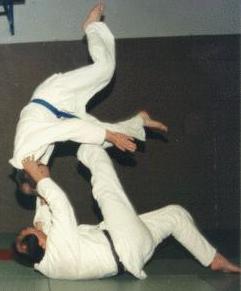
In martial arts, a throw is a grappling technique that involves off-balancing or lifting an opponent, and throwing them to the ground, in Japanese martial arts referred to as nage-waza, 投げ技, "throwing technique". Throws are a subset of takedown (grappling). Certain throwing techniques called sacrifice throws involve putting oneself in a potentially disadvantageous position, such as on the ground, in order to execute a throw.
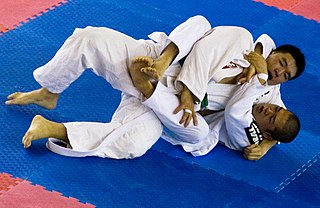
In combat sports, a spinal lock is a multiple joint lock applied to the spinal column, which is performed by forcing the spine beyond its normal ranges of motion. This is typically done by bending or twisting the head or upper body into abnormal positions. Commonly, spinal locks might strain the spinal musculature or result in a mild spinal sprain, while a forcefully and/or suddenly applied spinal lock may cause severe ligament damage or damage to the vertebrae, and possibly result in serious spinal cord injury, stroke, or death. Spinal locks and cervical locks are forbidden in IBJJF Brazilian jiu-jitsu competitions, amateur mixed martial artas (MMA), multiple forms of no Gi jiu-jitsu, judo, and other martial arts. However, professional MMA and some Brazilian jiu-jitsu competitions do permit spinal locks and, particularly, neck cranks, and such moves are trained in various MMA and Brazilian jiu-jitsu schools.
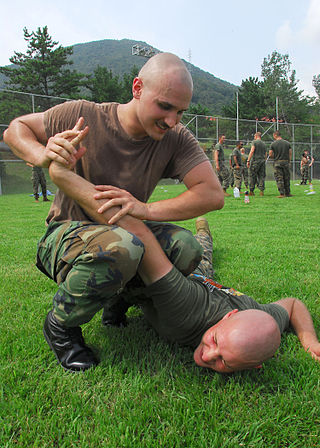
A wristlock is a joint lock primarily affecting the wrist-joint and, in some cases, the radioulnar joints through rotation of the hand. A wristlock is typically applied by grabbing the opponent's hand, and bending and/or twisting it. Wristlocks are very common in martial arts such as aikido, hapkido and jujutsu where they are featured as self-defense techniques. They are also used as submission holds in martial arts such as Brazilian jiu-jitsu and catch wrestling. While being an illegal technique in modern sambo and judo competitions, it is still practiced in judo forms of self-defense kata kōdōkan goshinjutsu. Wristlocks are also widely used as pain compliance holds, often in police, military, and residential treatment centers.















